Unit6 Let's go!期末复习考点讲义 2024-2025学年冀教版(2024)英语七年级上册
文档属性
| 名称 | Unit6 Let's go!期末复习考点讲义 2024-2025学年冀教版(2024)英语七年级上册 | 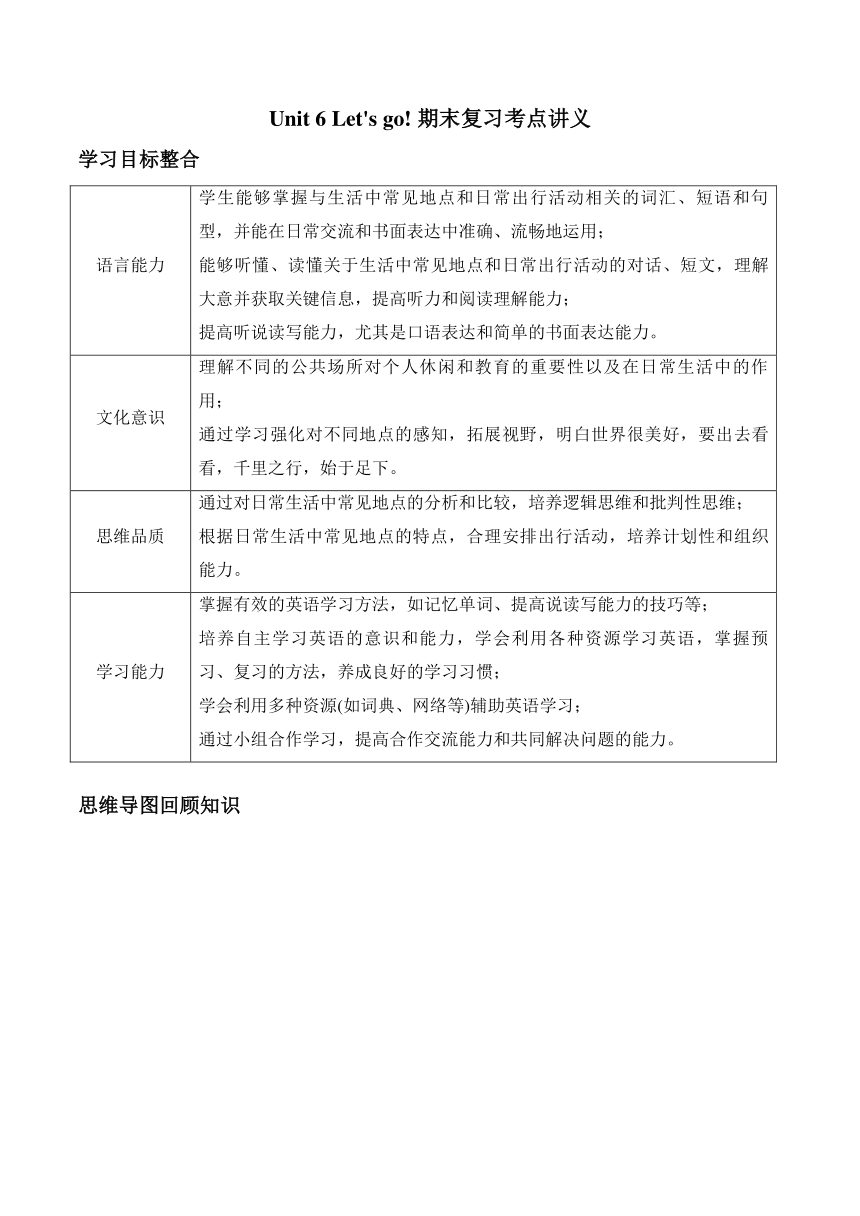 | |
| 格式 | docx | ||
| 文件大小 | 154.5KB | ||
| 资源类型 | 教案 | ||
| 版本资源 | 冀教版 | ||
| 科目 | 英语 | ||
| 更新时间 | 2024-12-26 23:01:30 | ||
图片预览

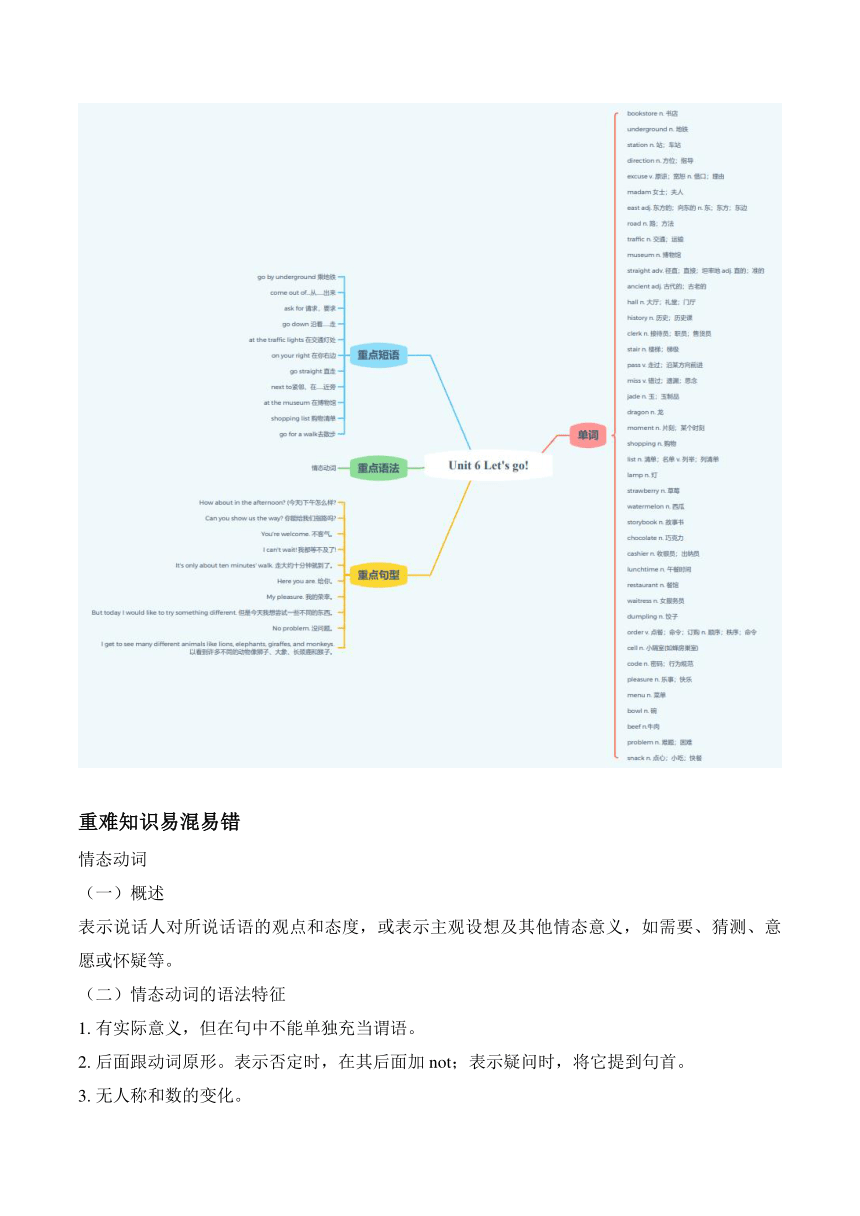
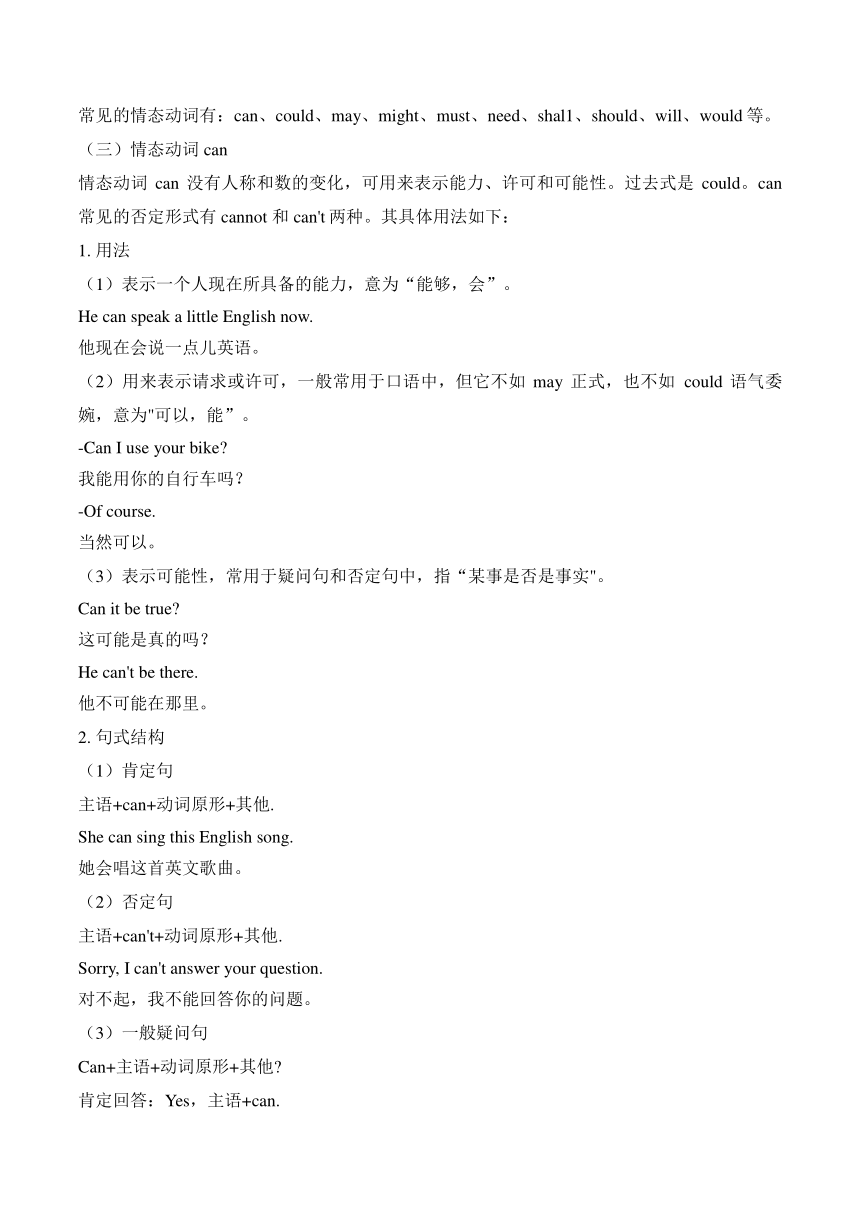
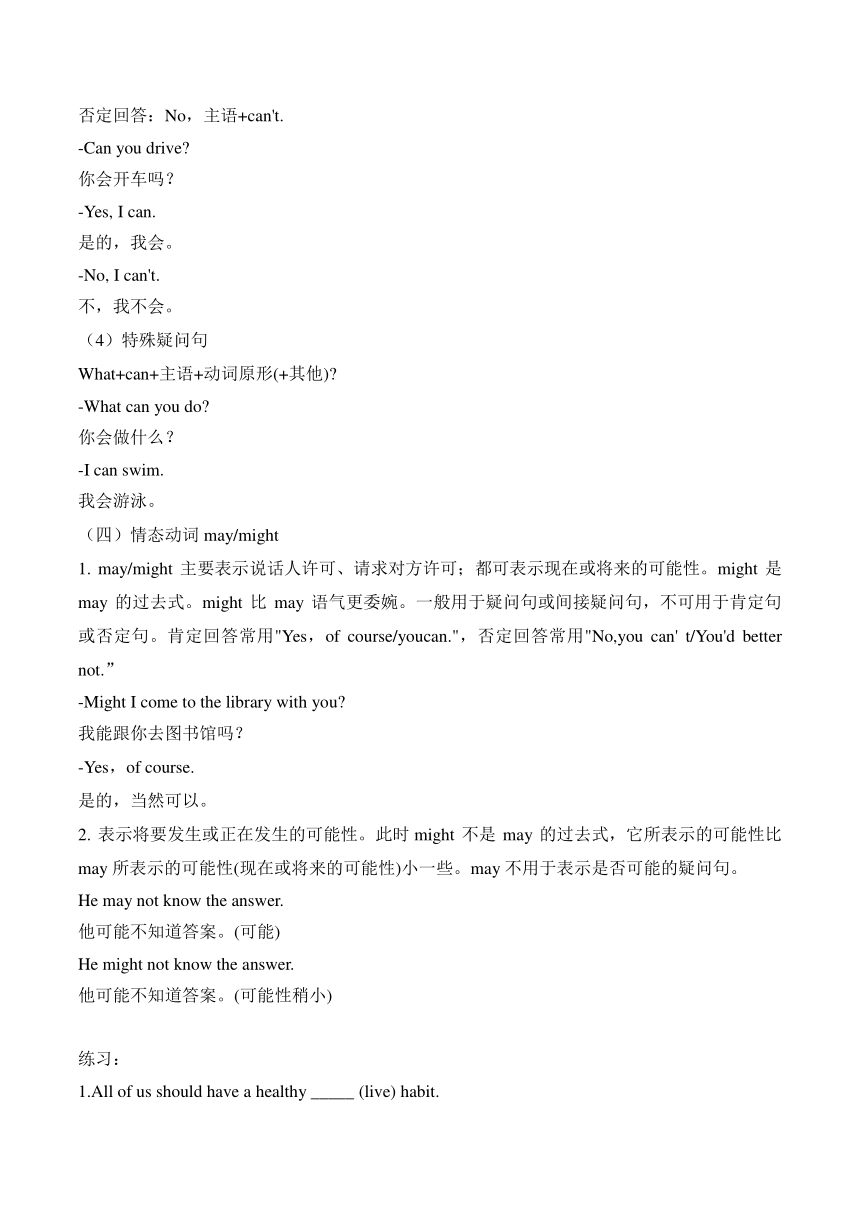
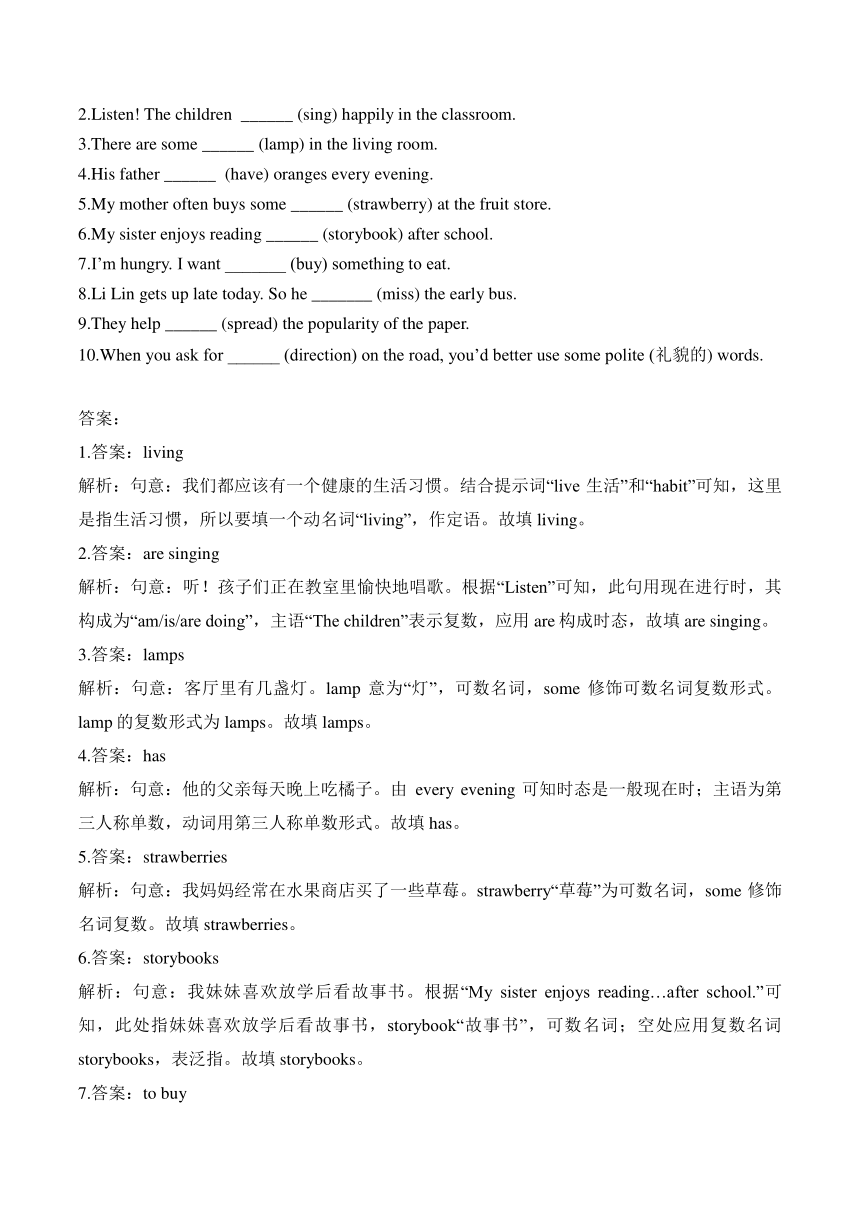
文档简介
Unit 6 Let's go! 期末复习考点讲义
学习目标整合
语言能力 学生能够掌握与生活中常见地点和日常出行活动相关的词汇、短语和句型,并能在日常交流和书面表达中准确、流畅地运用; 能够听懂、读懂关于生活中常见地点和日常出行活动的对话、短文,理解大意并获取关键信息,提高听力和阅读理解能力; 提高听说读写能力,尤其是口语表达和简单的书面表达能力。
文化意识 理解不同的公共场所对个人休闲和教育的重要性以及在日常生活中的作用; 通过学习强化对不同地点的感知,拓展视野,明白世界很美好,要出去看看,千里之行,始于足下。
思维品质 通过对日常生活中常见地点的分析和比较,培养逻辑思维和批判性思维; 根据日常生活中常见地点的特点,合理安排出行活动,培养计划性和组织能力。
学习能力 掌握有效的英语学习方法,如记忆单词、提高说读写能力的技巧等; 培养自主学习英语的意识和能力,学会利用各种资源学习英语,掌握预习、复习的方法,养成良好的学习习惯; 学会利用多种资源(如词典、网络等)辅助英语学习; 通过小组合作学习,提高合作交流能力和共同解决问题的能力。
思维导图回顾知识
重难知识易混易错
情态动词
(一)概述
表示说话人对所说话语的观点和态度,或表示主观设想及其他情态意义,如需要、猜测、意愿或怀疑等。
(二)情态动词的语法特征
1. 有实际意义,但在句中不能单独充当谓语。
2. 后面跟动词原形。表示否定时,在其后面加 not;表示疑问时,将它提到句首。
3. 无人称和数的变化。
常见的情态动词有:can、could、may、might、must、need、shal1、should、will、would等。
(三)情态动词 can
情态动词 can 没有人称和数的变化,可用来表示能力、许可和可能性。过去式是 could。can 常见的否定形式有 cannot 和 can't两种。其具体用法如下:
1. 用法
(1)表示一个人现在所具备的能力,意为“能够,会”。
He can speak a little English now.
他现在会说一点儿英语。
(2)用来表示请求或许可,一般常用于口语中,但它不如 may 正式,也不如could 语气委婉,意为"可以,能”。
-Can I use your bike
我能用你的自行车吗?
-Of course.
当然可以。
(3)表示可能性,常用于疑问句和否定句中,指“某事是否是事实"。
Can it be true
这可能是真的吗?
He can't be there.
他不可能在那里。
2. 句式结构
(1)肯定句
主语+can+动词原形+其他.
She can sing this English song.
她会唱这首英文歌曲。
(2)否定句
主语+can't+动词原形+其他.
Sorry, I can't answer your question.
对不起,我不能回答你的问题。
(3)一般疑问句
Can+主语+动词原形+其他
肯定回答:Yes,主语+can.
否定回答:No,主语+can't.
-Can you drive
你会开车吗?
-Yes, I can.
是的,我会。
-No, I can't.
不,我不会。
(4)特殊疑问句
What+can+主语+动词原形(+其他)
-What can you do
你会做什么?
-I can swim.
我会游泳。
(四)情态动词 may/might
1. may/might 主要表示说话人许可、请求对方许可;都可表示现在或将来的可能性。might 是 may 的过去式。might 比 may 语气更委婉。一般用于疑问句或间接疑问句,不可用于肯定句或否定句。肯定回答常用"Yes,of course/youcan.",否定回答常用"No,you can' t/You'd better not.”
-Might I come to the library with you
我能跟你去图书馆吗?
-Yes,of course.
是的,当然可以。
2. 表示将要发生或正在发生的可能性。此时might 不是 may 的过去式,它所表示的可能性比 may 所表示的可能性(现在或将来的可能性)小一些。may 不用于表示是否可能的疑问句。
He may not know the answer.
他可能不知道答案。(可能)
He might not know the answer.
他可能不知道答案。(可能性稍小)
练习:
1.All of us should have a healthy _____ (live) habit.
2.Listen! The children ______ (sing) happily in the classroom.
3.There are some ______ (lamp) in the living room.
4.His father ______ (have) oranges every evening.
5.My mother often buys some ______ (strawberry) at the fruit store.
6.My sister enjoys reading ______ (storybook) after school.
7.I’m hungry. I want _______ (buy) something to eat.
8.Li Lin gets up late today. So he _______ (miss) the early bus.
9.They help ______ (spread) the popularity of the paper.
10.When you ask for ______ (direction) on the road, you’d better use some polite (礼貌的) words.
答案:
1.答案:living
解析:句意:我们都应该有一个健康的生活习惯。结合提示词“live生活”和“habit”可知,这里是指生活习惯,所以要填一个动名词“living”,作定语。故填living。
2.答案:are singing
解析:句意:听!孩子们正在教室里愉快地唱歌。根据“Listen”可知,此句用现在进行时,其构成为“am/is/are doing”,主语“The children”表示复数,应用are构成时态,故填are singing。
3.答案:lamps
解析:句意:客厅里有几盏灯。lamp意为“灯”,可数名词,some修饰可数名词复数形式。lamp的复数形式为lamps。故填lamps。
4.答案:has
解析:句意:他的父亲每天晚上吃橘子。由every evening可知时态是一般现在时;主语为第三人称单数,动词用第三人称单数形式。故填has。
5.答案:strawberries
解析:句意:我妈妈经常在水果商店买了一些草莓。strawberry“草莓”为可数名词,some修饰名词复数。故填strawberries。
6.答案:storybooks
解析:句意:我妹妹喜欢放学后看故事书。根据“My sister enjoys reading…after school.”可知,此处指妹妹喜欢放学后看故事书,storybook“故事书”,可数名词;空处应用复数名词storybooks,表泛指。故填storybooks。
7.答案:to buy
解析:句意:我饿了。我想买点吃的。根据“I want…something to eat.”可知,此处是短语want to do sth.“想要做某事”,此处应用to buy。故填to buy。
8.答案:misses
解析:句意:李林今天起床晚了。所以他错过了早班车。根据“Li Lin gets up late today.”以及“he…the early bus”,可知,句子时态为一般现在时,he作主语,谓语动词应用动词的第三人称单数形式,miss的三单形式为misses。故填misses。
9.答案:to spread/spread
解析:句意:他们帮助传播报纸的知名度。help (to) do sth.“帮助做某事”,固定用法。故填(to) spread。
10.答案:directions
解析:句意:当你在路上问路时,你最好使用一些礼貌的词语。ask for directions表示“问路”,名词用复数表示泛指。故填directions。
核心素养对接中考
一、阅读理解
My husband and I are on an island (岛) for a long holiday with our two little daughters. When we talk about what to do next, our daughters tell us their ideas. We go to visit a butterfly museum together.
When we walk into the butterfly museum, we see thousands of beautiful butterflies. They all fly with their colourful wings (翼). My girls are jumping up and down, and I know it is a good idea to come to the museum. They are having so much fun.
I turn to our guide (导游) and ask, “How long do butterflies live ” She says, “For about ten days.”
“What can butterflies do in ten days ”
The guide stops, looks at me and says, “They make the world a more beautiful place.”
After we say goodbye, I think about the guide’s words. She is right. We all have something to give the world with the time we have. If we spend (花费) the time doing many things for others, we all can make the world a better place.
1.What do the writer’s two little daughters want to do
A.They want to go to visit an island.
B.They want to visit a butterfly museum.
C.They want to listen to the guide.
D.They want to make the world beautiful.
2.What makes the writer think visiting the butterfly museum a good idea
A.The writer is happy on the island.
B.They get a warm welcome in the museum.
C.The writer’s daughters are having a good time.
D.The writer knows interesting facts about butterflies.
3.How long does a butterfly live
A.About 10 days. B.About 10 weeks. C.About 10 months. D.About 10 years.
4.What does the writer mainly tell us in the last paragraph
A.Why they go to the butterfly museum. B.When they say goodbye to the guide.
C.What she learn from the guide’s words. D.How she makes her home a better place.
二、情景交际
A: Good morning! ① _____
B: Good morning! I will go to the Beijing Space Museum this weekend.
A: Is it your favourite place
B: ② _____ . I like to go there best.
A: Why do you like it best
B: Because there are lots of planes and cars there. I am interested in them.
A: ③ _____
B: I will go there in my father’s car. He is free that day. ④ _____
A: Yes, I’d love to. When will we meet
B: Let’s meet at 3 p.m. on Sunday. ⑤ _____
A: OK. See you that day.
B: See you.
三、写作
上周五,你们班去参观了神奇博物馆(the Amazing Museum)。回来后,用英语写一篇日记记述这次神奇之旅。要点:
1.了解了三明治的历史;
2.知道了长颈鹿的长脖子里仅有七块骨头;
3.自拟另一件神奇的事;
4.你的感受……(1—2点)
注意:
1.日记须包括所有要点,不要逐词翻译,可适当发挥,使日记连贯、通顺;
2.词数不少于60,日记的开头已给出,不计入总词数。
Today we had a class trip to the Amazing Museum.
____________________________________________________________________________________________________________________________________________________________________________________________________________________________________________________________________________________________________________________________________
答案以及解析
一、阅读理解
1.答案:B
解析:推理判断题。根据“ When we talk about what to do next, our daughters tell us their ideas. We go to visit a butterfly museum together.”可知,去参观蝴蝶博物馆的提议是作者的两个女儿提出的,故选B。
2.答案:C
解析:细节理解题。根据“My girls are jumping up and down, and I know it is a good idea to come to the museum.”可知,作者因女儿们在蝴蝶博物馆玩得开心而觉得参观蝴蝶博物馆是个好主意,故选C。
3.答案:A
解析:细节理解题。根据“I turn to our guide (导游) and ask, ‘How long do butterflies live ’ She says, ‘For about ten days.’ ”可知,一只蝴蝶的寿命为10天左右,故选A。
4.答案:C
解析:段落大意题。根据“If we spend (花费) the time doing many things for others, we all can make the world a better place.”以及整段的理解可知,最后一段主要讲了作者对导游所说的话的感想,故选C。
二、情景交际
答案: What will you do this weekend;Yes, it is;How will you get to the museum;Would you like to come with me;Is that OK
解析:①根据下文“I will go to the Beijing Space Museum this weekend.”可知,该处是询问对方周末要做什么。故填What will you do this weekend。
②根据上文“Is it your favourite place ”和下文的“I like to go there best.”可知,该处表示肯定。故填Yes, it is。
③根据下文“I will go there in my father’s car.”可知,该处是询问交通方式。故填How will you get to the museum。
④根据下文“ Yes, I’d love to.”可知,该处是询问对方是否一起去。故填Would you like to come with me。
⑤根据下文“OK”可知,该处是询问是否可以。故填Is that OK。
三、写作
答案:
Today we had a class trip to the Amazing Museum. At the museum, I learned a lot of amazing things. I learned about the history of sandwiches, and I knew that giraffes have only seven bones inside their long necks. Also, I learned that fish sleep with their eyes open.
We live in a world with so many wonderful things. When we think of these things, we will feel that our life is getting more and more colourful.
学习目标整合
语言能力 学生能够掌握与生活中常见地点和日常出行活动相关的词汇、短语和句型,并能在日常交流和书面表达中准确、流畅地运用; 能够听懂、读懂关于生活中常见地点和日常出行活动的对话、短文,理解大意并获取关键信息,提高听力和阅读理解能力; 提高听说读写能力,尤其是口语表达和简单的书面表达能力。
文化意识 理解不同的公共场所对个人休闲和教育的重要性以及在日常生活中的作用; 通过学习强化对不同地点的感知,拓展视野,明白世界很美好,要出去看看,千里之行,始于足下。
思维品质 通过对日常生活中常见地点的分析和比较,培养逻辑思维和批判性思维; 根据日常生活中常见地点的特点,合理安排出行活动,培养计划性和组织能力。
学习能力 掌握有效的英语学习方法,如记忆单词、提高说读写能力的技巧等; 培养自主学习英语的意识和能力,学会利用各种资源学习英语,掌握预习、复习的方法,养成良好的学习习惯; 学会利用多种资源(如词典、网络等)辅助英语学习; 通过小组合作学习,提高合作交流能力和共同解决问题的能力。
思维导图回顾知识
重难知识易混易错
情态动词
(一)概述
表示说话人对所说话语的观点和态度,或表示主观设想及其他情态意义,如需要、猜测、意愿或怀疑等。
(二)情态动词的语法特征
1. 有实际意义,但在句中不能单独充当谓语。
2. 后面跟动词原形。表示否定时,在其后面加 not;表示疑问时,将它提到句首。
3. 无人称和数的变化。
常见的情态动词有:can、could、may、might、must、need、shal1、should、will、would等。
(三)情态动词 can
情态动词 can 没有人称和数的变化,可用来表示能力、许可和可能性。过去式是 could。can 常见的否定形式有 cannot 和 can't两种。其具体用法如下:
1. 用法
(1)表示一个人现在所具备的能力,意为“能够,会”。
He can speak a little English now.
他现在会说一点儿英语。
(2)用来表示请求或许可,一般常用于口语中,但它不如 may 正式,也不如could 语气委婉,意为"可以,能”。
-Can I use your bike
我能用你的自行车吗?
-Of course.
当然可以。
(3)表示可能性,常用于疑问句和否定句中,指“某事是否是事实"。
Can it be true
这可能是真的吗?
He can't be there.
他不可能在那里。
2. 句式结构
(1)肯定句
主语+can+动词原形+其他.
She can sing this English song.
她会唱这首英文歌曲。
(2)否定句
主语+can't+动词原形+其他.
Sorry, I can't answer your question.
对不起,我不能回答你的问题。
(3)一般疑问句
Can+主语+动词原形+其他
肯定回答:Yes,主语+can.
否定回答:No,主语+can't.
-Can you drive
你会开车吗?
-Yes, I can.
是的,我会。
-No, I can't.
不,我不会。
(4)特殊疑问句
What+can+主语+动词原形(+其他)
-What can you do
你会做什么?
-I can swim.
我会游泳。
(四)情态动词 may/might
1. may/might 主要表示说话人许可、请求对方许可;都可表示现在或将来的可能性。might 是 may 的过去式。might 比 may 语气更委婉。一般用于疑问句或间接疑问句,不可用于肯定句或否定句。肯定回答常用"Yes,of course/youcan.",否定回答常用"No,you can' t/You'd better not.”
-Might I come to the library with you
我能跟你去图书馆吗?
-Yes,of course.
是的,当然可以。
2. 表示将要发生或正在发生的可能性。此时might 不是 may 的过去式,它所表示的可能性比 may 所表示的可能性(现在或将来的可能性)小一些。may 不用于表示是否可能的疑问句。
He may not know the answer.
他可能不知道答案。(可能)
He might not know the answer.
他可能不知道答案。(可能性稍小)
练习:
1.All of us should have a healthy _____ (live) habit.
2.Listen! The children ______ (sing) happily in the classroom.
3.There are some ______ (lamp) in the living room.
4.His father ______ (have) oranges every evening.
5.My mother often buys some ______ (strawberry) at the fruit store.
6.My sister enjoys reading ______ (storybook) after school.
7.I’m hungry. I want _______ (buy) something to eat.
8.Li Lin gets up late today. So he _______ (miss) the early bus.
9.They help ______ (spread) the popularity of the paper.
10.When you ask for ______ (direction) on the road, you’d better use some polite (礼貌的) words.
答案:
1.答案:living
解析:句意:我们都应该有一个健康的生活习惯。结合提示词“live生活”和“habit”可知,这里是指生活习惯,所以要填一个动名词“living”,作定语。故填living。
2.答案:are singing
解析:句意:听!孩子们正在教室里愉快地唱歌。根据“Listen”可知,此句用现在进行时,其构成为“am/is/are doing”,主语“The children”表示复数,应用are构成时态,故填are singing。
3.答案:lamps
解析:句意:客厅里有几盏灯。lamp意为“灯”,可数名词,some修饰可数名词复数形式。lamp的复数形式为lamps。故填lamps。
4.答案:has
解析:句意:他的父亲每天晚上吃橘子。由every evening可知时态是一般现在时;主语为第三人称单数,动词用第三人称单数形式。故填has。
5.答案:strawberries
解析:句意:我妈妈经常在水果商店买了一些草莓。strawberry“草莓”为可数名词,some修饰名词复数。故填strawberries。
6.答案:storybooks
解析:句意:我妹妹喜欢放学后看故事书。根据“My sister enjoys reading…after school.”可知,此处指妹妹喜欢放学后看故事书,storybook“故事书”,可数名词;空处应用复数名词storybooks,表泛指。故填storybooks。
7.答案:to buy
解析:句意:我饿了。我想买点吃的。根据“I want…something to eat.”可知,此处是短语want to do sth.“想要做某事”,此处应用to buy。故填to buy。
8.答案:misses
解析:句意:李林今天起床晚了。所以他错过了早班车。根据“Li Lin gets up late today.”以及“he…the early bus”,可知,句子时态为一般现在时,he作主语,谓语动词应用动词的第三人称单数形式,miss的三单形式为misses。故填misses。
9.答案:to spread/spread
解析:句意:他们帮助传播报纸的知名度。help (to) do sth.“帮助做某事”,固定用法。故填(to) spread。
10.答案:directions
解析:句意:当你在路上问路时,你最好使用一些礼貌的词语。ask for directions表示“问路”,名词用复数表示泛指。故填directions。
核心素养对接中考
一、阅读理解
My husband and I are on an island (岛) for a long holiday with our two little daughters. When we talk about what to do next, our daughters tell us their ideas. We go to visit a butterfly museum together.
When we walk into the butterfly museum, we see thousands of beautiful butterflies. They all fly with their colourful wings (翼). My girls are jumping up and down, and I know it is a good idea to come to the museum. They are having so much fun.
I turn to our guide (导游) and ask, “How long do butterflies live ” She says, “For about ten days.”
“What can butterflies do in ten days ”
The guide stops, looks at me and says, “They make the world a more beautiful place.”
After we say goodbye, I think about the guide’s words. She is right. We all have something to give the world with the time we have. If we spend (花费) the time doing many things for others, we all can make the world a better place.
1.What do the writer’s two little daughters want to do
A.They want to go to visit an island.
B.They want to visit a butterfly museum.
C.They want to listen to the guide.
D.They want to make the world beautiful.
2.What makes the writer think visiting the butterfly museum a good idea
A.The writer is happy on the island.
B.They get a warm welcome in the museum.
C.The writer’s daughters are having a good time.
D.The writer knows interesting facts about butterflies.
3.How long does a butterfly live
A.About 10 days. B.About 10 weeks. C.About 10 months. D.About 10 years.
4.What does the writer mainly tell us in the last paragraph
A.Why they go to the butterfly museum. B.When they say goodbye to the guide.
C.What she learn from the guide’s words. D.How she makes her home a better place.
二、情景交际
A: Good morning! ① _____
B: Good morning! I will go to the Beijing Space Museum this weekend.
A: Is it your favourite place
B: ② _____ . I like to go there best.
A: Why do you like it best
B: Because there are lots of planes and cars there. I am interested in them.
A: ③ _____
B: I will go there in my father’s car. He is free that day. ④ _____
A: Yes, I’d love to. When will we meet
B: Let’s meet at 3 p.m. on Sunday. ⑤ _____
A: OK. See you that day.
B: See you.
三、写作
上周五,你们班去参观了神奇博物馆(the Amazing Museum)。回来后,用英语写一篇日记记述这次神奇之旅。要点:
1.了解了三明治的历史;
2.知道了长颈鹿的长脖子里仅有七块骨头;
3.自拟另一件神奇的事;
4.你的感受……(1—2点)
注意:
1.日记须包括所有要点,不要逐词翻译,可适当发挥,使日记连贯、通顺;
2.词数不少于60,日记的开头已给出,不计入总词数。
Today we had a class trip to the Amazing Museum.
____________________________________________________________________________________________________________________________________________________________________________________________________________________________________________________________________________________________________________________________________
答案以及解析
一、阅读理解
1.答案:B
解析:推理判断题。根据“ When we talk about what to do next, our daughters tell us their ideas. We go to visit a butterfly museum together.”可知,去参观蝴蝶博物馆的提议是作者的两个女儿提出的,故选B。
2.答案:C
解析:细节理解题。根据“My girls are jumping up and down, and I know it is a good idea to come to the museum.”可知,作者因女儿们在蝴蝶博物馆玩得开心而觉得参观蝴蝶博物馆是个好主意,故选C。
3.答案:A
解析:细节理解题。根据“I turn to our guide (导游) and ask, ‘How long do butterflies live ’ She says, ‘For about ten days.’ ”可知,一只蝴蝶的寿命为10天左右,故选A。
4.答案:C
解析:段落大意题。根据“If we spend (花费) the time doing many things for others, we all can make the world a better place.”以及整段的理解可知,最后一段主要讲了作者对导游所说的话的感想,故选C。
二、情景交际
答案: What will you do this weekend;Yes, it is;How will you get to the museum;Would you like to come with me;Is that OK
解析:①根据下文“I will go to the Beijing Space Museum this weekend.”可知,该处是询问对方周末要做什么。故填What will you do this weekend。
②根据上文“Is it your favourite place ”和下文的“I like to go there best.”可知,该处表示肯定。故填Yes, it is。
③根据下文“I will go there in my father’s car.”可知,该处是询问交通方式。故填How will you get to the museum。
④根据下文“ Yes, I’d love to.”可知,该处是询问对方是否一起去。故填Would you like to come with me。
⑤根据下文“OK”可知,该处是询问是否可以。故填Is that OK。
三、写作
答案:
Today we had a class trip to the Amazing Museum. At the museum, I learned a lot of amazing things. I learned about the history of sandwiches, and I knew that giraffes have only seven bones inside their long necks. Also, I learned that fish sleep with their eyes open.
We live in a world with so many wonderful things. When we think of these things, we will feel that our life is getting more and more colourful.
同课章节目录
